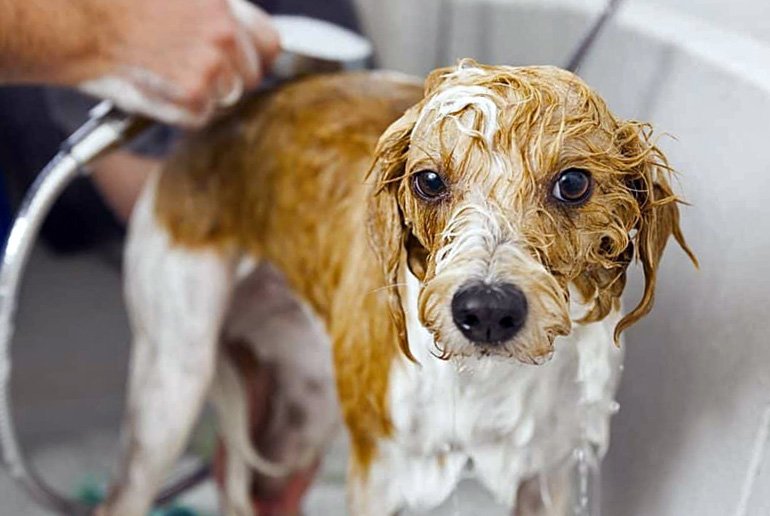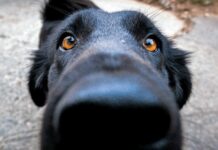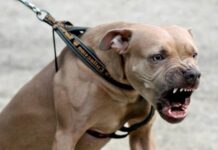Anyone who is lucky enough to have a dog knows how complicated it can be to give them a bath, whether in the house, at a groomer or in the yard. How do you bathe your dog or puppy without dying in the attempt? It’s very simple. Just follow the steps explained in this post and you’ll see how you can quickly bathe your dog at home with no trouble at all.
Not all dogs will object to a nice bath, but the fact is, most dogs aren’t exactly docile when it’s bath time. In this post, besides showing you how to bathe your dog in a way that’s natural, healthy and hassle-free, we’ll look at how often to bathe them, what shampoo to use, and what to do after their bath. It’s definitely worth taking five minutes to read this whole article, because it will be very helpful, trust me.
Where should I wash my dog?
The time has come to give you dog or puppy a bath and get him completely clean so you can snuggle up with him like you would with your kids, but… where should you bathe him? It’s very simple.
You can bathe your dog in your bathtub at home, in the shower, in the yard, or in a specialized center (usually vet clinics that offer grooming services or offer their facilities so you can bathe your dog yourself).
Use common sense. If your dog is very large, obviously a small shower isn’t going to be the best place, since he’ll barely fit and it will be quite uncomfortable for both of you to do the bath there.
However, if your dog is medium-size or small, you can bathe him in your shower at home no problem, as there is enough space for both of you to feel comfortable during the bath. If you decide to give him a bath in your yard with the help of a bucket or a hose, it’s very important to consider the temperature outside.
You should choose a sunny day with a mild temperature to bathe your dog if you decide to do it outdoors, because, just like humans, being cold can make them sick (kennel cough) or, in extreme cases, die. Always use your head and don’t make your dog do anything you wouldn’t do yourself.
People with very small dogs have the advantage of being able to bathe them practically anywhere, in a bucket, in the sink, in the bathtub… But always make sure the temperature is appropriate.
Never wash your dog with shampoo in a lake, river or at the beach, because shampoo contains substances that are harmful for the environment and could kill other animals. Besides, most towns do not allow it.
If your pup is younger than six months, you need to follow different steps: When and how to bathe a puppy.
How to bathe a dog the right way
The first thing you need to remember is that you need to turn bath time into a game. This is the only way your dog will overcome his fear of baths, and gradually he’ll even start to enjoy a nice bath from you.
Don’t forget that we transmit our emotional state to our pets, so if you are tense or nervous, they will notice, and they’ll get tense and nervous too. Keep a positive, cheerful, playful attitude. Caress your dog and use toys to lead him to the place you’ve chosen to bathe him.
It’s a good idea to brush your dog before you wash him to get rid of the loose fur so that the bath is more effective.
Once you’re in the bath area (we’ll use a bathtub at home as an example, since it’s the most common), you have two options: leave your dog untethered, or secure his leash to the faucet or other anchor point. It all depends on if your dog tends to run away from the tub or not. If you decide to use a leash, do it gently and lovingly, letting him feel your positive energy.
The bathtub should be completely empty. Don’t fill it with water or anything else, that will come later (and with the help of a handheld showerhead, a hose or the faucet—never filling the tub).
If it helps, you can bring a few toys to the bathtub so that your dog feels more relaxed. This is useful with many dogs. Remember to play around and pet him; you want to get his mind off the bath and focused on you and having fun.
Now that your dog is in the tub, it’s time to start washing, but… what do you need for the bath?
- A special dog shampoo (never use human shampoo or soap, only shampoos and soaps designed specifically for dogs)
- Some dry towels for after the bath
- A hair dryer
To start the bath, take the handheld shower head or attachment (if you have one) and adjust the temperature so that it’s not too hot. It should be quite warm, but never hot enough to burn you.
One trick is to run the water over your wrist after you’ve adjusted the temperature, like you would with a baby’s bottle to make sure it’s not too hot. Don’t forget to open the stopper on the drain; you want the water to drain out, not fill up the tub.
Once the water is the right temperature, begin to slowly and gently wet your dog. Keep in mind that it’s very likely your dog will shake off when he feels the water, which will soak everything nearby.
Carefully wet your dog, gently massaging the area where you are spraying the water so that it gets all the way into his fur. Be especially careful not to spray water directly at his eyes, nose or ears. It’s best to get his head wet using only your hands, not the shower head, taking care not to get water in his eyes, ears or nose.
When you dog is nice and wet, liberally apply the dog shampoo or soap and massage all over, forming a lather and making sure the soap penetrates his fur. It’s important to keep your dog from ingesting the foam, which happens pretty often, but can cause vomiting, diarrhea or digestive problems.
Remember that it’s extremely important not to get soap (or suds) in your dog’s nose, eyes, mouth or ears. It can be very harmful and irritating for him. Take your time and do everything calmly and gently while you play around and talk to him.
Once your dog is all lathered up, it’s time to rinse the soap off with warm water. Rinse your dog carefully to remove any residual soap/shampoo. It’s a good idea to rinse two or even three times, even if you think you’ve gotten all the soap off. This way, he’ll be rinsed completely clean.
If you’re bathing your dog in a bucket or out in the yard, use the same method. If you’re outside and it’s hotter than 85 degrees out, you don’t need to heat the water and can use cool (but not freezing) water instead.
Now that your dog is rinsed off, all that’s left to do is dry him off to finish bath time.
How to dry a dog after a bath
If it’s a nice day, with a mild or warm temperature (at least 75 degrees), you can take a walk with your dog and let him dry off naturally. You can also dry him off a bit with a towel and then walk him.
If it’s too cold out or you just don’t want to use this option, you should carefully dry off your dog so that he doesn’t catch cold.
Ideally, you would use dry towels, as many as necessary to get him more or less dry. Let him shake a few times, which will help get the water out of his fur so that you can dry him faster and more effectively.
Once you’ve finished with the towels, it’s time to finish drying with the hair dryer. Remember that hair dryers blow extremely hot air, so don’t hold it too close to your dog. Just use it to blow dry and get him completely dry but without burning him. A good trick to avoid burning him is to put your hand in the area where you’re drying him.
Remember, it’s very important not to point the hair dryer directly at your dogs face, since the hot air can dry out his eyes and nose, which is very irritating. So… are we done drying yet? Nope. Now that your dog is dry, use some gauze to dry inside his ears (and clean them while you’re in there to prevent ear infection). Now you’re done with the drying process.
How often should I bathe my dog?
Dogs have a fine layer of oil on their skin that is secreted naturally. This layer disappears after every bath and takes a day or two to come back. It’s not advisable to give your dog a bath very often as a general rule. However, if he gets very dirty, if he rolled around in poop (lying down in other animals’ poop is quite common in dogs) or if he just smells bad, you can wash him even if it hasn’t been long since his last bath.
Some breeds don’t take well to baths, like the Hungarian Puli, for example, although you probably already know that. But most breeds and mixes tolerate regular baths very well.
It’s best to give your dog a bath once a month, although some people do it every month and a half or two months. If your dog lives inside the house, once a month is a good option. On the other hand, if he lives outside, he can probably go a little longer with no problem.
As always, common sense is a must. If your dog lives inside, is clean, doesn’t smell and doesn’t usually get dirty on walks… then maybe you can go two months between baths instead of one.
Remember to wait at least a couple days after a bath before applying a pipette of flea medicine to protect him from fleas, ticks and other parasites. If your dog wears a flea collar like Scalibor or similar, you can remove it for bathing so it doesn’t get wet.
Tips for washing your dog
- When your dog is dry and a day or two after his bath, brush him again to remove loose fur. Remember you should brush him before bathing as well.
- Never forget to turn the bath into a game. Having fun bathing him and making sure he has fun too is very important.
- Never bathe your dog right after a meal. Between his nervousness and the water, you could give him indigestion. Wait at least three hours after he’s eaten.
- If your dog is aggressive or mischievous, tying his leash to something is a good option. And, in extreme cases, you should use a muzzle.
- If you don’t like bathing your dog, don’t do it. Let a professional do it for you. They don’t charge a lot and they’ll leave your dog perfectly clean.
- Remember to use a soap specifically for dogs. This is very important because their pH is very different from ours.
- If your dog is still a puppy, you can use this as an opportunity to make bath time something super fun so he’s never afraid of baths.
- If your dog has an open wound or had an operation recently, wait until it’s completely healed.
- Likewise, if your dog is sick, you should wait until he’s fully recovered before bathing him.





